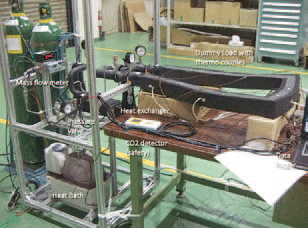KEK Annual Report 2010
For highly integrated modern detector systems, a
very efficient and reliable cooling system is one of the
most critical components. In this project, we develop a
two-phase cooling technology that adopts the concept
of cooling with fluids in mixed states and makes use of
the large latent heat for liquids vaporizing into gases,
thereby achieving highly efficient extraction of heat with
a low flow rate of the coolant fluids. It should be emphasized
that the temperature of the coolant is determined
solely by the pressure and hence is nearly constant
along the entire cooling circuit. This is because the absorbed
heat is used only for phase transition. As a coolant,
CO2 is considered ideal because of its large latent
heat and an operating pressure that can be set very
high to minimize the vapor volume, ensuring high cooling
power even with thin cooling pipes, while keeping the pressure drop negligible to realize nearly uniform
temperature along the cooling line.
In order to develop
a two-phase CO2 cooling system for a large-scale experiment
in the next generation, we formed an R&D
team in FY2010. As our first milestone, we started developing
an open two-phase CO2 cooling system, as
shown in Fig. 4-6-3-2. The system consists of a CO2
bottle, a heat exchanger that precools the input liquid
with the return two-phase mixture, a needle valve to
turn the liquid into the two-phase (liquid/vapor) mixture,
a dummy heat load, a pressure valve, and a heat bath
to fully vaporize the CO2 for venting it to the atmosphere.
In FY2011, the system will be tested and used to accumulate
data as a basis for developing a closed system.
 |
| Fig. 1 Open two-phase CO2 cooling system |
 2-Phase CO2 Cooling System
2-Phase CO2 Cooling System